MARIANI’S
Virtual Gourmet
May 5,
2019
NEWSLETTER
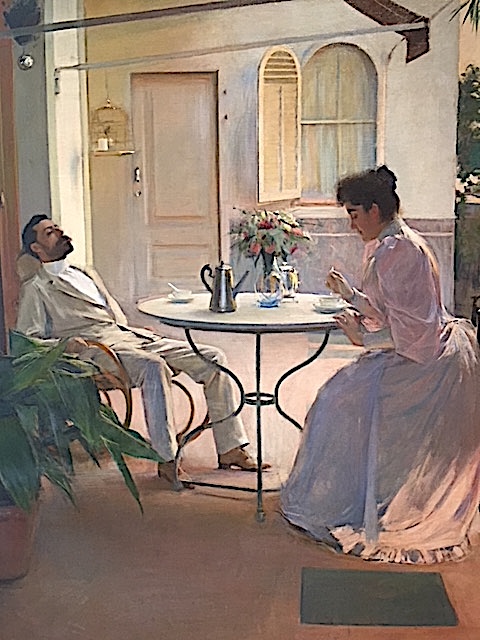
❖❖❖
IN THIS ISSUE
LAUSANNE
By John Mariani
NEW YORK CORNER
GABRIEL KREUTHER
By John Mariani
NOTES FROM THE WINE CELLAR
IT TAKES A FARMER TO BE A GOOD WINEMAKER:
AN INTERVIEW WITH TOM GAMBLE
By John Mariani
❖❖❖
LAUSANNE
By John Mariani
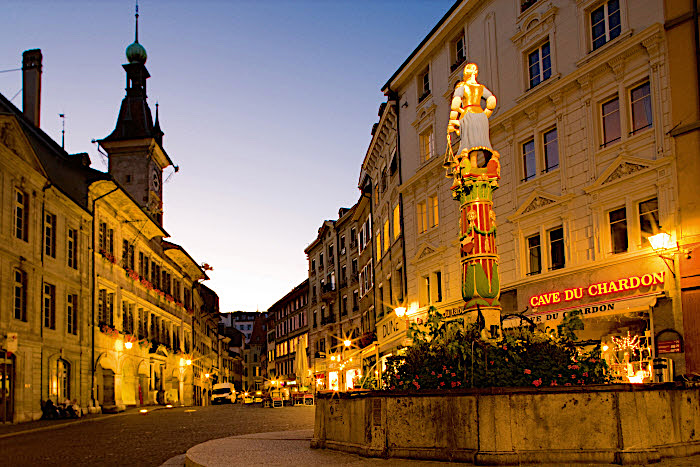
Place de la Palud, Lausanne
Photo: Swiss Tourism: Christof Scheurpf
Caressing one the loveliest curves of Lake Leman and conveniently located between Paris and the French Riviera, Lausanne was once a principal stop along the Grand Tour, when wealthy young British men and women of the 18th and 19th centuries spent at least a year on the Continent, learning French, polishing their manners and absorbing whatever culture they could while sowing their wild oats.
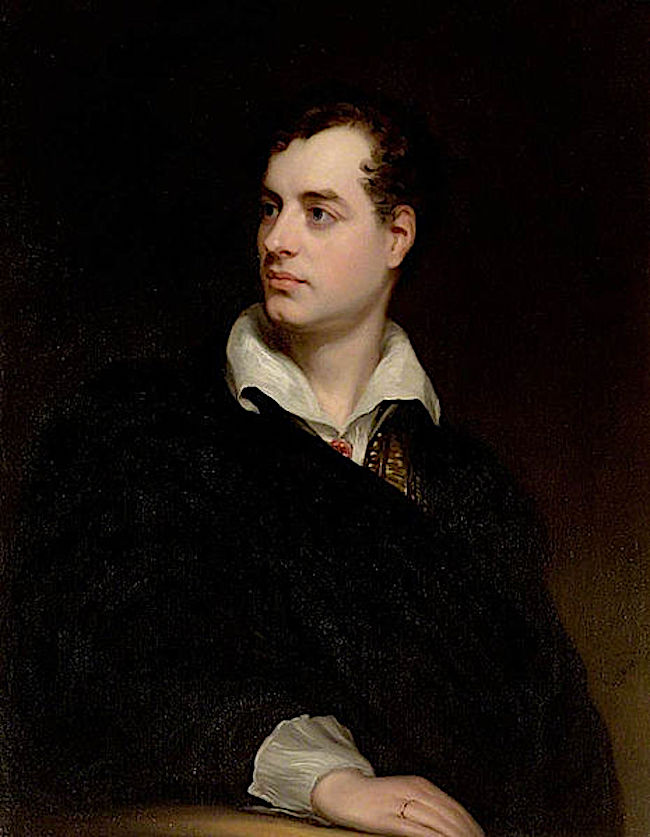 Lausanne
was usually the next stop after Paris—carriages
were often dismantled to get
them through the Alps—and few cities have such a
long literary history. It was
in Lausanne that Edward Gibbons, author of The History
of the Decline and Fall of the
Roman Empire, lived for five years as a
youth and in 1783 to finish the
last volume of that monumental work. His house—now
a post office—became a
requisite visit for tourists like the poets Percy
Bysshe Shelley and Lord
Byron (left),
who wrote one of his most famous poems, “The
Prisoner of Chillon” in
Lausanne in 1816.
Charles Dickens
wrote parts of Dombey and
Son
(1846-1848) there, and in the next century T.S.
Eliot, while under psychiatric
care in Lausanne, composed most of his poem “The
Waste Land,” with the sad line, “By the waters of Leman I sat
down and wept ….”
Lausanne
was usually the next stop after Paris—carriages
were often dismantled to get
them through the Alps—and few cities have such a
long literary history. It was
in Lausanne that Edward Gibbons, author of The History
of the Decline and Fall of the
Roman Empire, lived for five years as a
youth and in 1783 to finish the
last volume of that monumental work. His house—now
a post office—became a
requisite visit for tourists like the poets Percy
Bysshe Shelley and Lord
Byron (left),
who wrote one of his most famous poems, “The
Prisoner of Chillon” in
Lausanne in 1816.
Charles Dickens
wrote parts of Dombey and
Son
(1846-1848) there, and in the next century T.S.
Eliot, while under psychiatric
care in Lausanne, composed most of his poem “The
Waste Land,” with the sad line, “By the waters of Leman I sat
down and wept ….”
In
the 19th century the city was central to what
became known as “Alpinism,” the
climbing of mountains for sport and wonderment—a
new idea in contrast to a
previous view that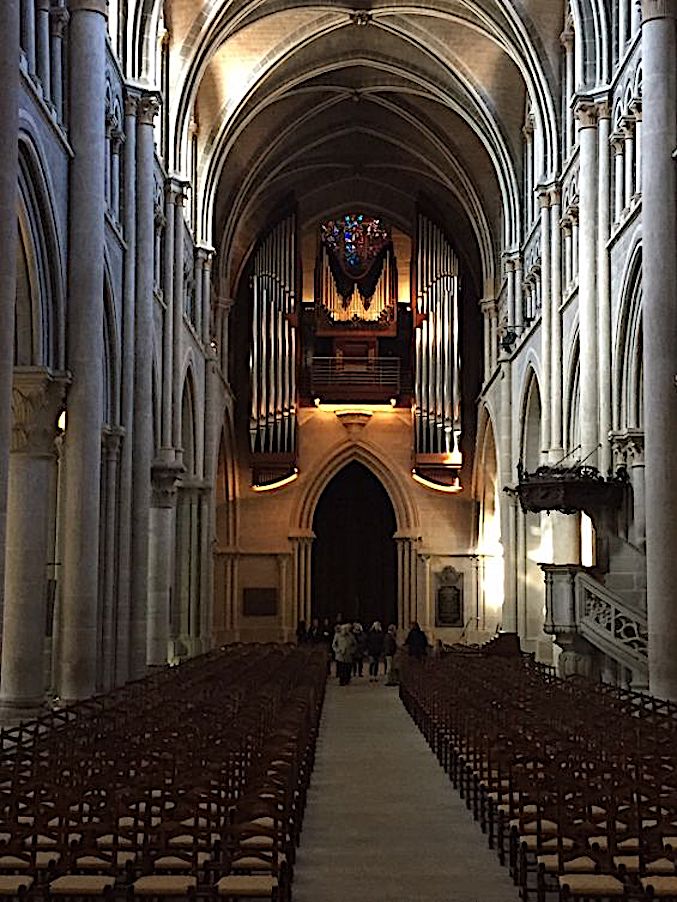 mountains
were forbidding, gloomy places best left to
hunters. Skiing came later and the resorts
Champery and Les Diablerets are only
about an hour’s drive.
mountains
were forbidding, gloomy places best left to
hunters. Skiing came later and the resorts
Champery and Les Diablerets are only
about an hour’s drive.
Lausanne is a city of steeply angled hills, divided into 18 quartiers, and at this point its population of 140,000 is composed of 42% foreign nationals. Once an important city of the Protestant Reformation, it later became a far more Catholic city, owing to an influx of late 20th century immigrants.
The 13th century Cathedral of Notre-Dame (right), on Lausanne’s highest point, is one of the city’s principal cultural sites, with a belltower that has always been a look-out point for the city’s defenders. Its religious images, once removed by the iconoclastic Protestants, were restored over two centuries, with a grand 7,000-pipe organ built over ten years by an American company, and a façade with a statue of a horned Moses looking like the Cowardly Lion in The Wizard of Oz.
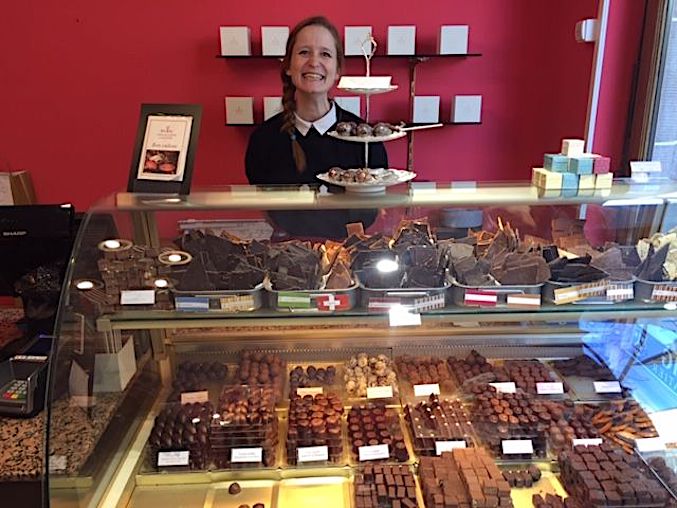 Though
spread
out over 16 square miles, the city is made for
walking, although its
quiet, always-on-time rubber-tire metro system,
now eleven years old, makes navigating
any part of the city very easy. One of the
prettiest sections is the Place de
la Palud, with a tower clock whose figures emerge
and move each hour, and an
array of food shops and stalls selling scores of
cheeses and dairy products,
chocolates and other distinctly Swiss products.
Nearby is the charmingly small
Durig Chocolaterie (left) on the Rue Mercerie, where
you can attend demos and classes
in chocolate-making. All the chocolates are made
from organic and fair-traded
beans, and their variety is geared to the
holidays.
Though
spread
out over 16 square miles, the city is made for
walking, although its
quiet, always-on-time rubber-tire metro system,
now eleven years old, makes navigating
any part of the city very easy. One of the
prettiest sections is the Place de
la Palud, with a tower clock whose figures emerge
and move each hour, and an
array of food shops and stalls selling scores of
cheeses and dairy products,
chocolates and other distinctly Swiss products.
Nearby is the charmingly small
Durig Chocolaterie (left) on the Rue Mercerie, where
you can attend demos and classes
in chocolate-making. All the chocolates are made
from organic and fair-traded
beans, and their variety is geared to the
holidays. 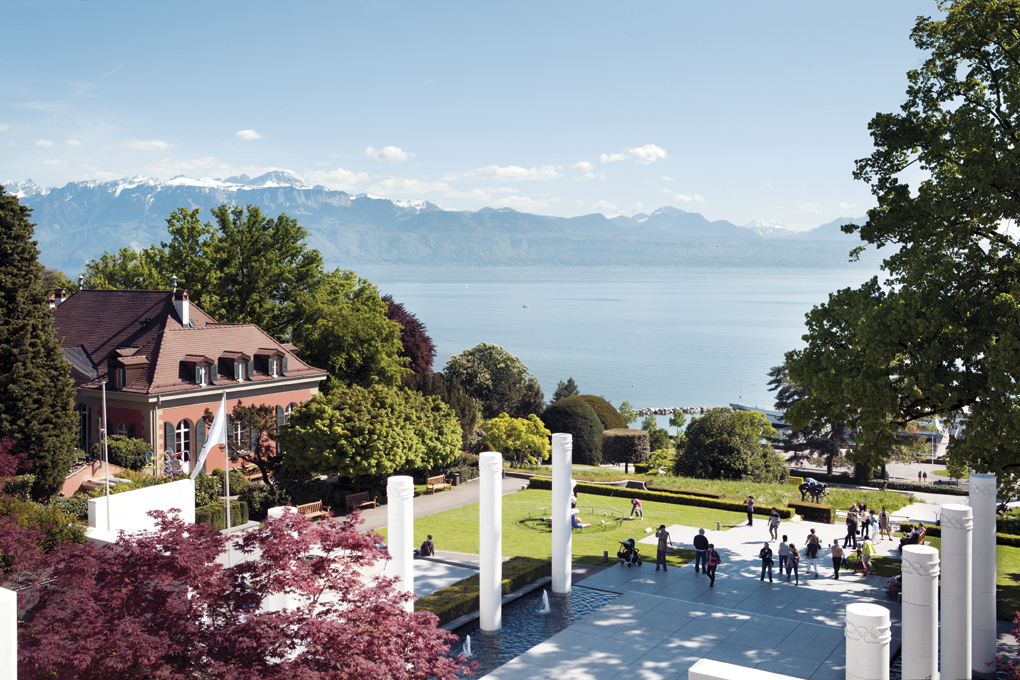
The
Quartier du Flon has become Lausanne’s trendy
neighborhood, with plenty of new
bars, restaurants—most of them not
serving traditional Swiss 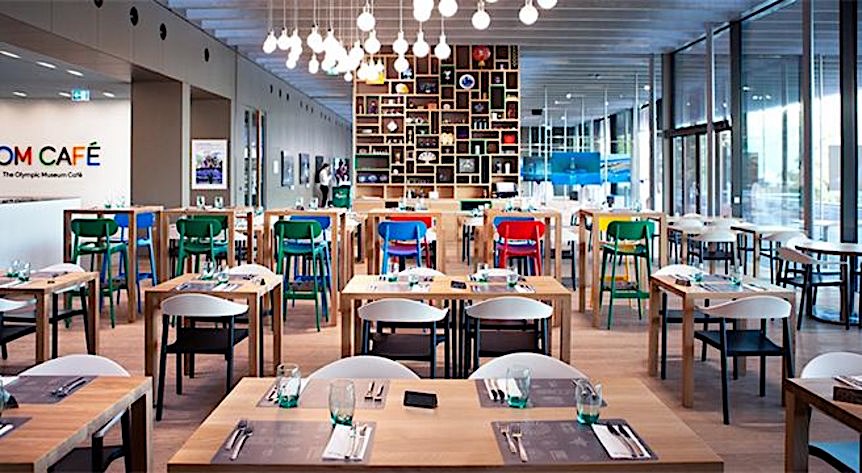 food—galleries
and boutiques. (Look for the “red
points” that denote shops having good sales.)
food—galleries
and boutiques. (Look for the “red
points” that denote shops having good sales.)
Lausanne is rife with fine museums, including ones devoted to the arts, zoology, archaeology, contemporary design, money, and even the typewriter. But the two attractions not to be missed are the Olympic Museum, with numerous interactive exhibitions, dozens of medal winners’ uniforms, videos of all previous summer and winter games and hundreds of items of memorabilia, from ticket stubs and programs to toboggans and boxing gloves. It is also a center for studies of the games. On premises is a bright, colorful TOM café (below) where you can get soups, salads, sandwiches and pastas at very good prices.
❖❖❖
By John Mariani
GABRIEL
KREUTHER
41 West 42nd
Street (near
Sixth Avenue)
212-257-5826
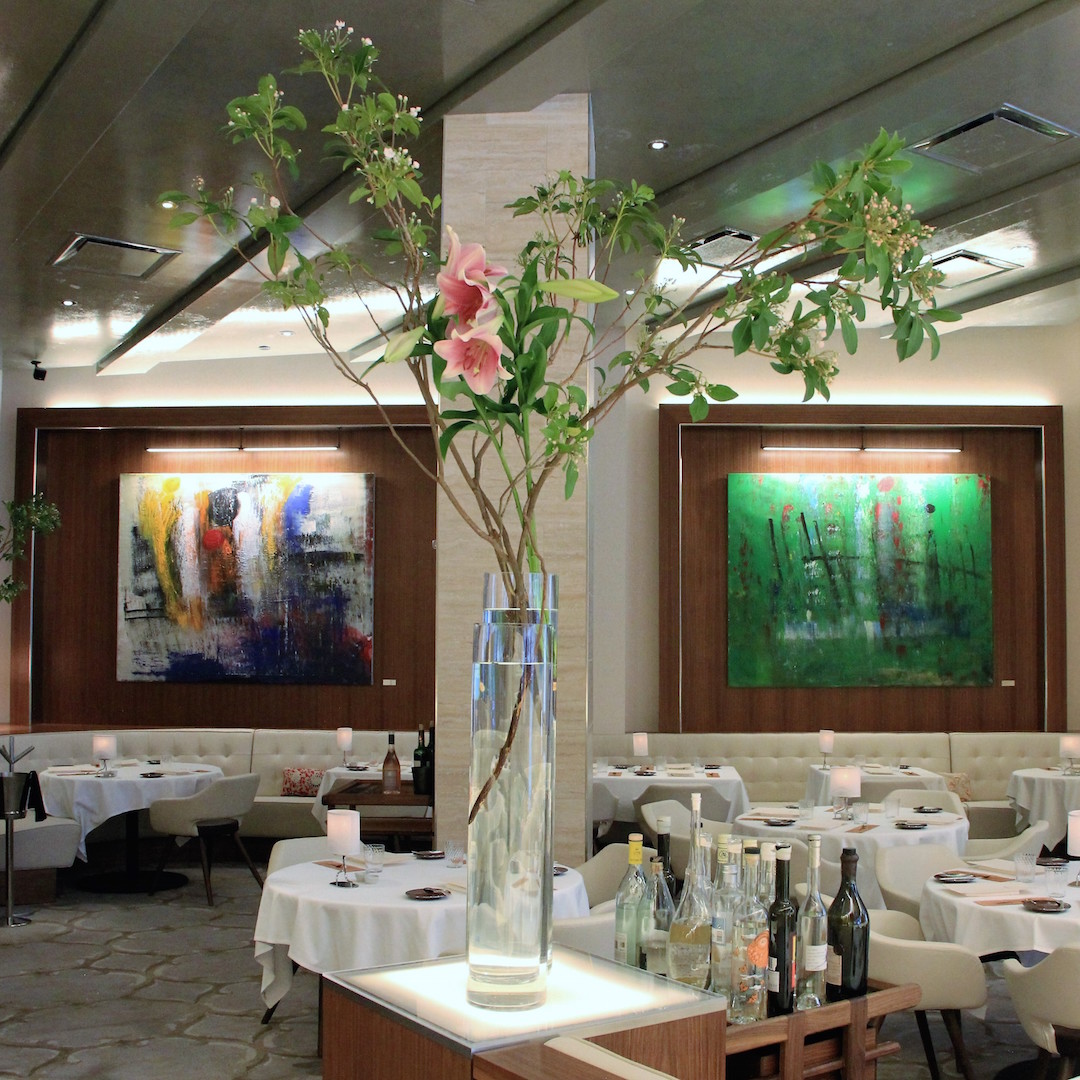
Since my last report on Gabriel Kreuther and his restaurant, two significant events have occurred. First, he and pastry chef Marc Aumont opened a wildly successful chocolate shop next door, and, second, the Michelin Guide awarded the restaurant two stars (which, in the tire company’s archaic jargon, means “Worth a detour”). I might also mention that prices for a four-course dinner have gone up, from $125 to $155 (with supplements), which is on a par with Le Bernardin ($157) and Daniel ($158) but still well below La Grénouille’s three-course menu ($172).
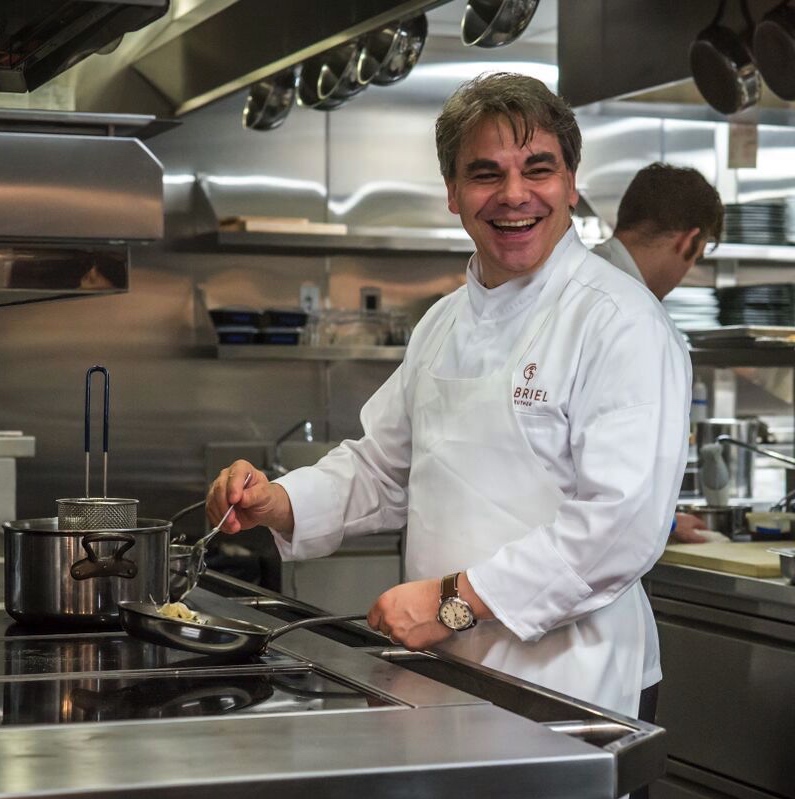 Kreuther first made
his mark at his fellow Alsatian chef
Jean-Georges Vongerichten’s namesake
restaurant, then at The Modern, before
becoming chef-partner at his own eponymous
100-seat restaurant across from
Bryant Park in 2015.
Kreuther first made
his mark at his fellow Alsatian chef
Jean-Georges Vongerichten’s namesake
restaurant, then at The Modern, before
becoming chef-partner at his own eponymous
100-seat restaurant across from
Bryant Park in 2015.
The décor of the main dining room and bar evoke Kreuther’s Alsatian background via street lamp light fixtures, huge wooden beams, an etched-glass wall adorned with stork imagery, and a stainless-steel bar top, but all of it with a glowing modernity. The kitchen staff can be seen working behind a wide glass wall.
The retro-style chairs are extremely comfortable and the lamp-lighted tables are set with thick linens and napkins, so civilized conversation is possible. I’m still not in love with the long fondue-like silverware, which will be forever awkward to handle.
The Bar, by
the way, with its own lighter menu ranging
from snacks
($12-$24) to tartes
flambées
($18-$24) and large plates ($18-$34), is
immensely popular after six p.m., and
it’s a very comfortable spot to meet friends
for drinks before or 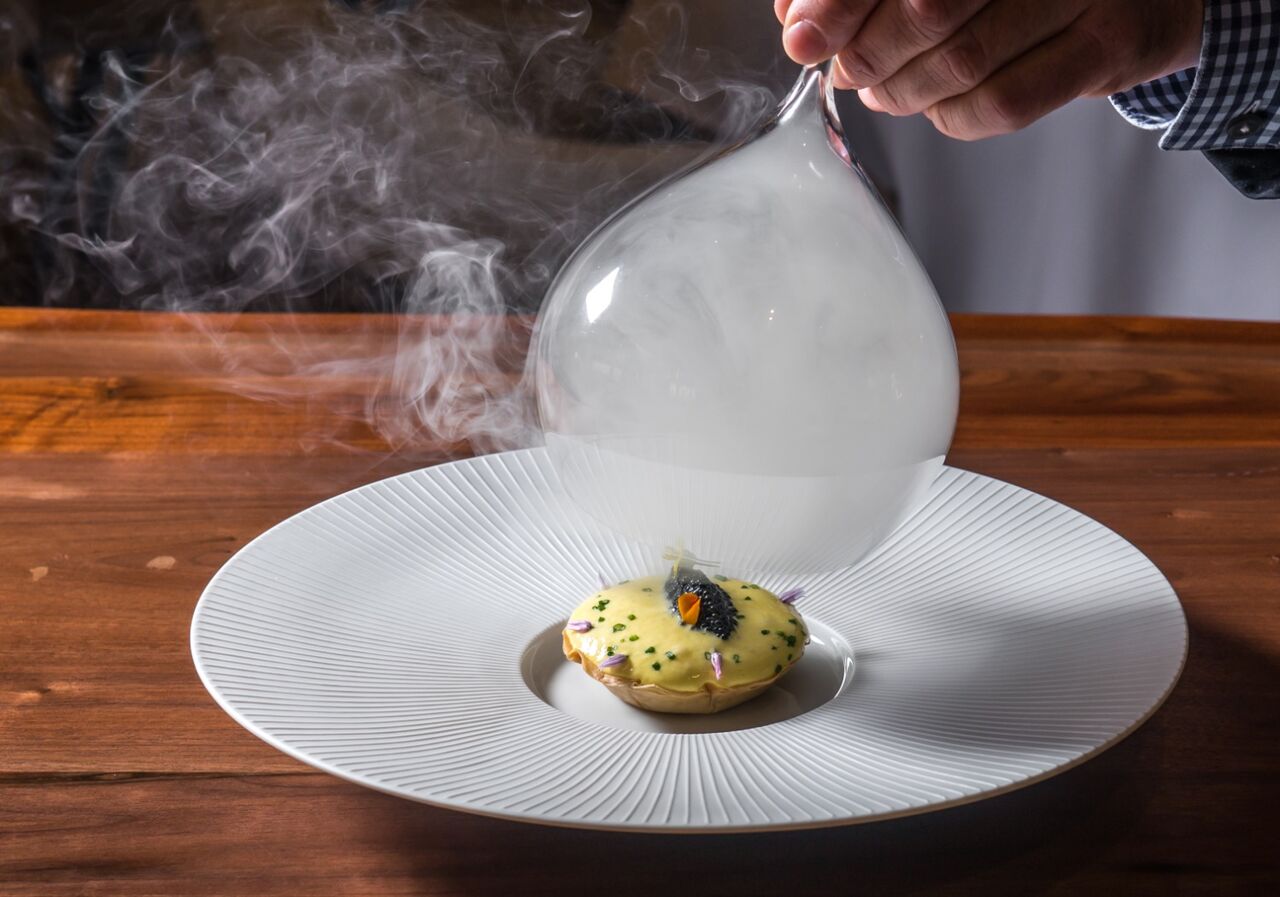 after
theater. Now added to all the menus is the
option of cinco jotas ham from patas
negras pigs, deftly carved into square
slices by an expert at your table
($42). If you must have caviar, there are two
expensive options (neither from
the Caspian Sea, where sturgeon fishing is now
banned).
after
theater. Now added to all the menus is the
option of cinco jotas ham from patas
negras pigs, deftly carved into square
slices by an expert at your table
($42). If you must have caviar, there are two
expensive options (neither from
the Caspian Sea, where sturgeon fishing is now
banned).
Bread is an essential part of Kreuther’s service, so you get wonderful kinds throughout the meal, all with delicious butters and spreads. Everyone also receives at least one amuse.
Many dishes
from the original menu have become signatures,
while new
additions prove that Kreuther, Chef de Cuisine
Joe Anthony and his crew continue to refine
what has become a
cuisine that is uniquely his. Of the former
there is still the remarkable
course of sturgeon and sauerkraut with
American caviar mousseline set within a
smoking bell jar (right). Perennially
available is the lush langoustine
tartare with flying fish roe, cauliflower,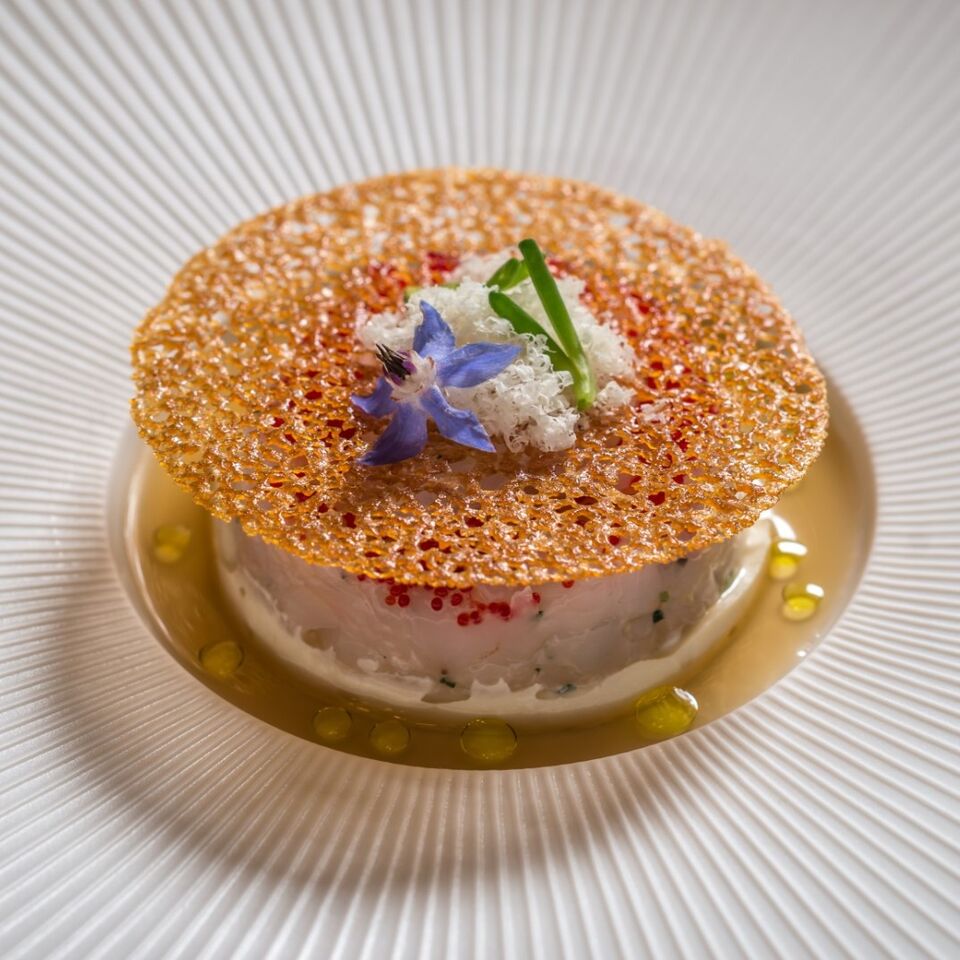 and
macadamia puree (left).
I’ll always love the terrine of creamy foie
gras with brittle black truffled
praline, now served with cider-poached quince,
pomegranate and chestnut
cornbread. The hamachi is also treated to the
luxury of black truffles and foie
gras in a delicate millefeulle pastry.
and
macadamia puree (left).
I’ll always love the terrine of creamy foie
gras with brittle black truffled
praline, now served with cider-poached quince,
pomegranate and chestnut
cornbread. The hamachi is also treated to the
luxury of black truffles and foie
gras in a delicate millefeulle pastry.
Among the second courses there is more foie gras, this time seared and served with a sweet apricot preserve, smoked prosciutto and an amaretto gastrique that helps cut the richness of the dish.
A
marvelous new item is emmer pasta, perfectly
cooked, mixed with a confit egg
yolk, pancetta bacon and given texture and
chewiness with sunflower seeds.
Right now white asparagus are in season and
Kreuther does them and green
asparagus en papilotte (for two people)—along
with a pretty green asparagus
soup. 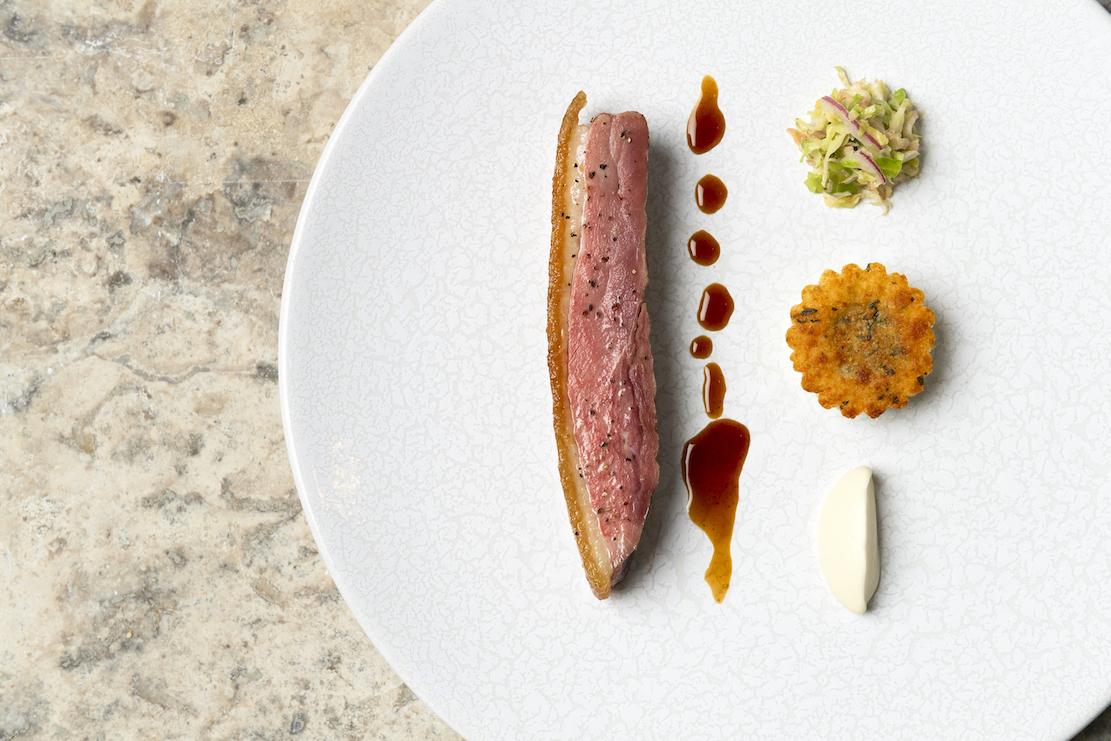
The third courses begin with buckwheat-roasted black bass with briny bouchot mussels (farm raised in France by a technique with a history dating to the 13th century), whose hot spicing of chorizo and a harissa rouille enhances the fish without compromising it. Kreuther has managed to find some of the most flavorful, well-fatted heritage pork available, served with grilled cabbage, apple brown butter and grits.
Cause for the most applause at our table was duck breast for two (right), baked with salted celeriac, eucalyptus and a truffle coulis. It was one of those rare moments when I thought I’d never before had duck this flavorful, this juicy, this beautifully cooked and presented. The oddest dish is a rack of Australian lamb, inferior by far to American lamb, demanding a $15 surcharge. It comes in a haystack with lamb bacon and roasted barley.
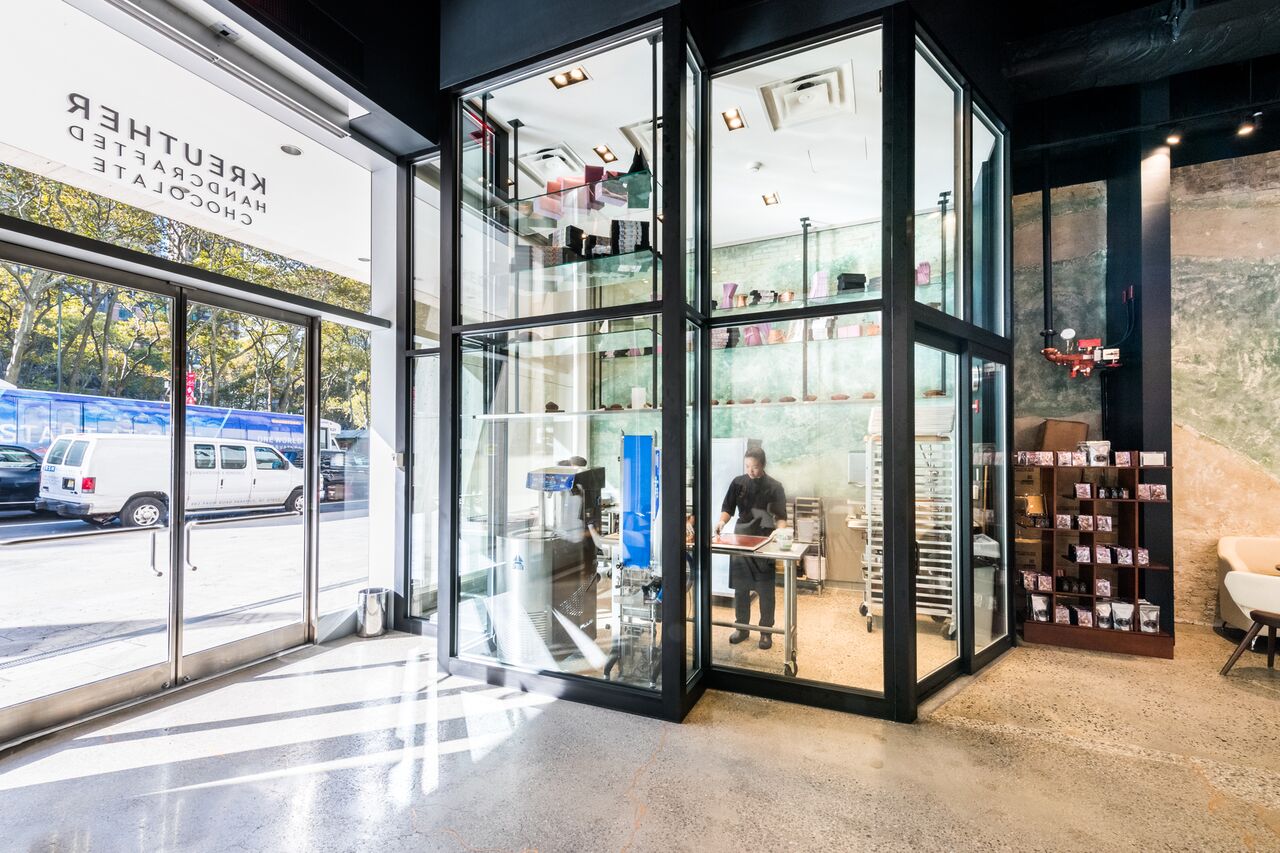 I
should add that my descriptions
of these dishes does not include an array of
additions and sauces explained in
detail by the first-rate staff. Wine director
Philippe Sauriat stocks a list to match,
with 1,800 selections.
I
should add that my descriptions
of these dishes does not include an array of
additions and sauces explained in
detail by the first-rate staff. Wine director
Philippe Sauriat stocks a list to match,
with 1,800 selections.
For the
last course you may have cheese or dessert,
and the cheese selections are
always superb. But I take personal pride in
the very sophisticated desserts
because my enchanting daughter-in-law
Priscilla is the restaurant's Pastry Chef,
under Executive Pastry Chef Marc Aumont.
These,
too, are even better than I remember, from a caramel-chocolate
parfait with halvah
and yuzu sorbet to poached rhubarb
with milk sorbet and Turkish tea
gelée. Lighter is a plate of wild
strawberries—and I emphasize the word “wild”
because they are so rare in this country—with
a buttermilk panna cotta and
almond biscuit. And. of course, you'll receive
chocolates of the kind sold next door at the
shop (left).
There is also available a 6-course tasting menu at $195, nine courses at $235, and wine pairings available between $85 and $230.
In just four years Gabriel Kreuther has shown that the market for fine dining remains at a very high and consistent level, and he does so by stretching his well-honed talents to embrace new ideas that, as in all great restaurants, reflect his own personal history and a devotion to what is enduring, without ever giving in to the next fleeting trend.
Open for lunch Mon.-Fri.; Dinner Mon.-Sat.
BE A GOOD WINEMAKER:
AN INTERVIEW WITH TOM GAMBLE
By John Mariani
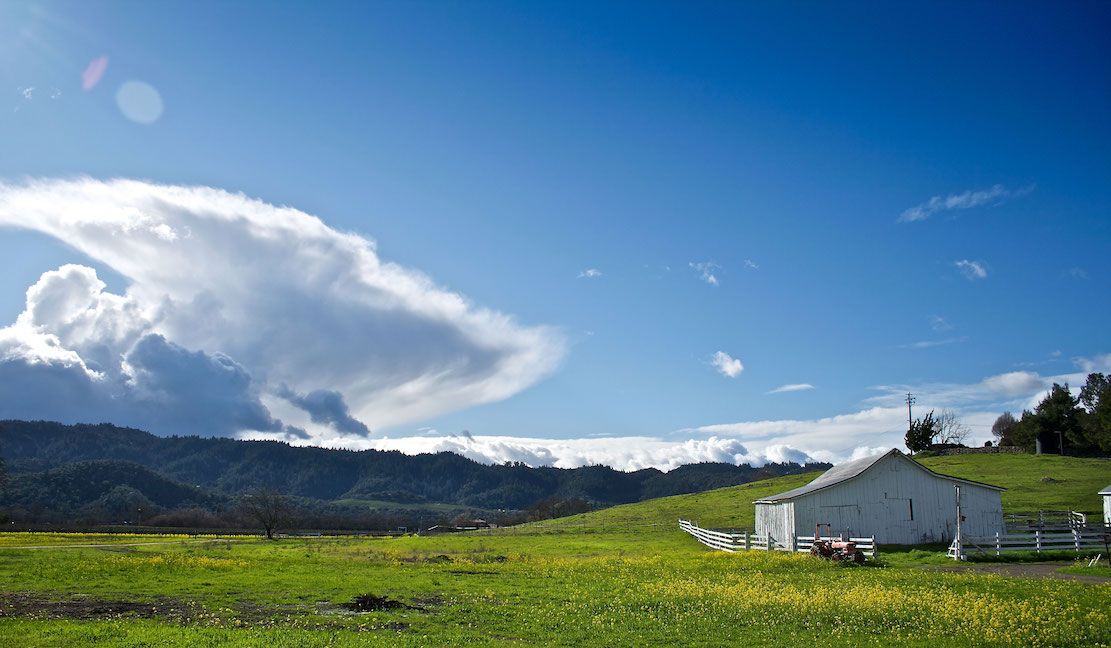
The kind of conversation I usually have with most winemakers revolves around mind-numbingly arcane terms like pH levels, Brix, grape genomes and phenolic maturity. But when I sit down with Tom Gamble of Gamble Family Vineyards, the word I am most likely to hear, repeatedly, is “farmer”—spoken with equal weight given to pride and grit.
For, while he is as knowledgeable as any vintner I’ve ever met about grape growing and wine making, he does not come off as a homespun hayseed, suffer delusions of being a “gentleman farmer” and certainly does not pose as one of those zillionaires who thinks it would be such fun to buy a Napa Valley vineyard and make Cabernets designed to win awards from Wine Advocate and Wine Spectator.
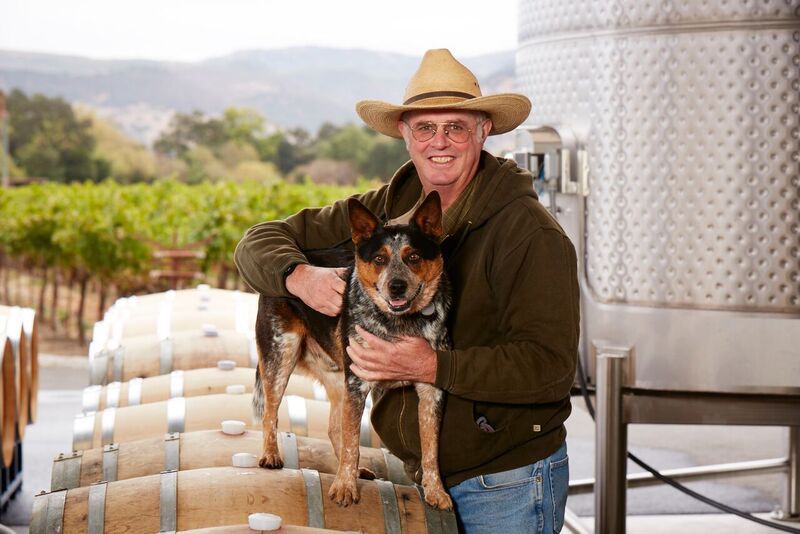 Gamble is a
third-generation Napa farmer, with a hundred
years of both cattle and agriculture history
behind him. Gamble’s mother, Mary
Ann McGuire, was active in establishing1968’s
Napa Valley Agricultural
Preserve, which protects vineyards and
wineries from commercial development and
ensures that the land is used strictly for
agricultural purposes. A
century in the same spot has allowed Gamble to
know intimately the distinctions
of the
valley’s microclimates and
terroirs, so that his winery’s 75 acres
include several of the most respected
AVAs, like Oakville, Mt. Veeder, Rutherford
and Yountville.
He also knows undiscovered plots he can
maximize.
Gamble is a
third-generation Napa farmer, with a hundred
years of both cattle and agriculture history
behind him. Gamble’s mother, Mary
Ann McGuire, was active in establishing1968’s
Napa Valley Agricultural
Preserve, which protects vineyards and
wineries from commercial development and
ensures that the land is used strictly for
agricultural purposes. A
century in the same spot has allowed Gamble to
know intimately the distinctions
of the
valley’s microclimates and
terroirs, so that his winery’s 75 acres
include several of the most respected
AVAs, like Oakville, Mt. Veeder, Rutherford
and Yountville.
He also knows undiscovered plots he can
maximize.
“My most lasting memory of childhood is dirt,” says Gamble, who is tall, robust and looks a bit like a younger Bob Newhart. “Playing in dirt. Walking in dust behind the tractor. Wandering aimlessly on foot, horseback and mini-bike all summer long—enjoying everything the dirt and our climate gives to life.”
Still, Gamble
Family
Vineyards was founded only fourteen years ago,
the winery built in 2012. He
has never sought to be the 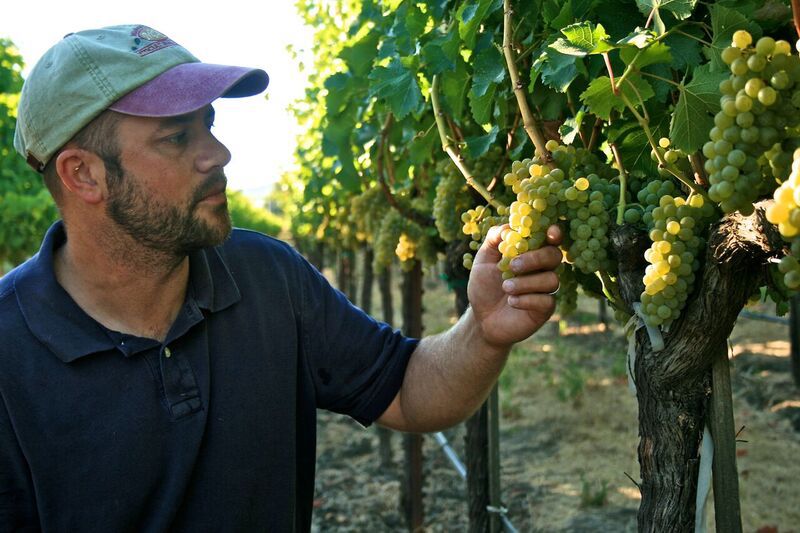 biggest
grower or vintner in the valley, and even now
he produces only about 10,000
cases a year, much of it sold at the winery or
through subscription (about a
thousand). His wines are now sold in 30
states.
biggest
grower or vintner in the valley, and even now
he produces only about 10,000
cases a year, much of it sold at the winery or
through subscription (about a
thousand). His wines are now sold in 30
states.
From the start Gamble knew he didn’t want to make wines in the Napa blockbuster style. As for those wines with high alcohol levels, Gamble contends, “Don’t let them tell you that such levels are due to the kind of weather and sun we get in Napa. That’s just b.s. They deliberately make them that way, just to win 90-plus points from the wine media.”
Gamble’s wines are made closer to the Bordeaux style, using both French and California grape clones he believes thrive best in one plot or another, aiming for “vivacity, richness and lift,” rather than high tannins and oaky flavors. He and winemaker Jim Close (right), a Brit who’s been at the estate since the beginning, age in “neutral oak barrels,” aiming for a balance of fruit, tannin and acidity that will go well with food.
I am among many who are big fans of Gamble’s Cabernet Sauvignons, which I shared with him over dinner in New York at Gabriel Kreuther, but I was yet again particularly impressed with his Sauvignon Blanc, which has none of that cloying fruit punch taste you find in New Zealand and West Coast examples, or the overly grassy flavors other wineries produce.
“You have to remember
Sauvignon Blanc used to be a cash crop in
California,” he said, “with big
tonnage for optimum sales to people who liked
that sweet, grassy style. And
farmers love to follow a trend to death. When
I bought 12 acres of Heart Block,
I used two French clones, one from the Loire
Valley, spaced out the vines and
trellised them to sunlight, pruned them back
and adopted Cabernet Sauvignon
techniques as of 1977. 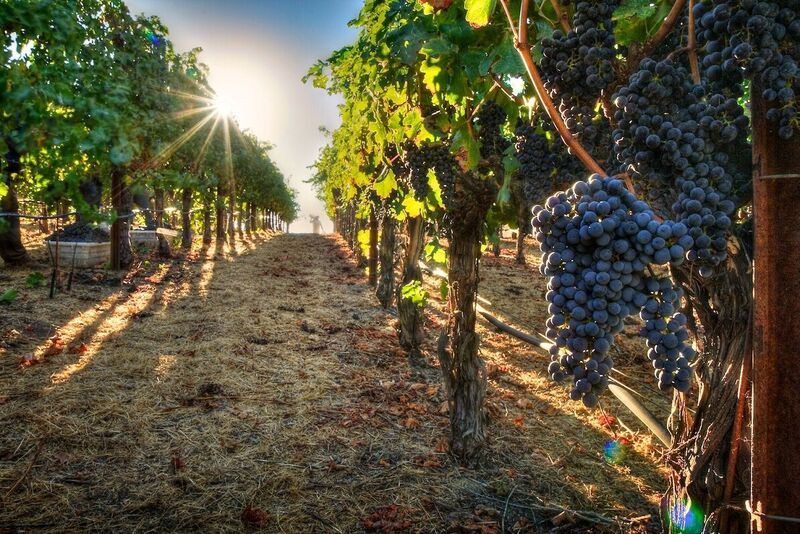 The
grapes
were hand harvested, gently pressed using
native yeast and aged for 18 months.
Others use oak too aggressively to make it
smoky, but I want a fresh, citrus
acidity that will keep the wine maturing for
the next several years.” The 2017
sells for $25.
The
grapes
were hand harvested, gently pressed using
native yeast and aged for 18 months.
Others use oak too aggressively to make it
smoky, but I want a fresh, citrus
acidity that will keep the wine maturing for
the next several years.” The 2017
sells for $25.
Gamble names two of his
Cabernets after his parents—G. Thomas and
MaryAnn. Cairo is a Cab
named after his rescue dog (no longer alive).
What I love about Gamble’s
Cabs is that they can be bold, at least on
first tasting, but that levels of
flavor are released on the palate  and show that
blending judicious amounts of
Merlot, Cabernet Franc and Petit Verdot gives
the Cabernet Sauvignon base far
more complexity. The percentages vary widely:
the 2015 Family Home ($120) is
100% Cab Sauvignons; the 2015 Napa Valley
Cabernet Sauvignon ($60) is 83% Cab
Sauvignon; the 2015 Paramount ($90) is only
32%. He also makes a 100% Cabernet
Franc from four different appellations.
and show that
blending judicious amounts of
Merlot, Cabernet Franc and Petit Verdot gives
the Cabernet Sauvignon base far
more complexity. The percentages vary widely:
the 2015 Family Home ($120) is
100% Cab Sauvignons; the 2015 Napa Valley
Cabernet Sauvignon ($60) is 83% Cab
Sauvignon; the 2015 Paramount ($90) is only
32%. He also makes a 100% Cabernet
Franc from four different appellations.
I also feel that by keeping his Cabs at alcohol levels just above 14% and less than 14.5%, they are far easier to enjoy with a meal rather than overpower it and cause both literal and palate fatigue over a long meal.
I asked Gamble his opinions on global warming in California and, while he believes wholly that it is happening, he also takes a farmer’s approach to combating it, or even using it to his benefit. He’s already hired a climatologist.
“We’re seeing disturbing spikes in the weather,” he said. “I’m more concerned with what the night time temperatures will be, because Napa can get very hot during the day but historically cools off at night. Ironically, if the sea levels rise, that may have a moderating effect on the wines. It only makes sense to start placing the vines farther above ground to help cool them.”
Gamble thinks a lot about all this, not to mention payroll, machinery, animal husbandry and sales, which is why he works 80-hour weeks and gets up at 4:30 in the morning.
“Daybreak in Napa is very special,” he said, “and it never gets old for me when it’s quiet, the animals are awake and the Valley is cool—the way it’s always been and the way I want it to stay.”
❖❖❖
FROM THE MAN WHO
SAID,
“There's
nothing wrong with having a tree as a
friend.”
Bob Ross, painter
and television host, who died in 1995, is
now the inspiration for FYE entertainment
stores to release Bob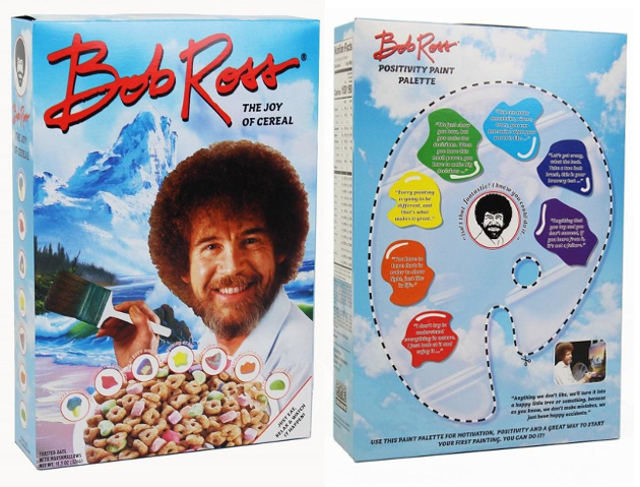 Ross: The Joy of
Cereal, ($12.99), which is
similar to Lucky Charms in being composed of
toasted oat pieces and a variety of different
color marshmallow shapes that include happy little
trees, accidents, mountains, stars, rainbow
hearts and bushes. “Just eat, relax &
watch it happen!” reads the front of the box.
Ross: The Joy of
Cereal, ($12.99), which is
similar to Lucky Charms in being composed of
toasted oat pieces and a variety of different
color marshmallow shapes that include happy little
trees, accidents, mountains, stars, rainbow
hearts and bushes. “Just eat, relax &
watch it happen!” reads the front of the box.
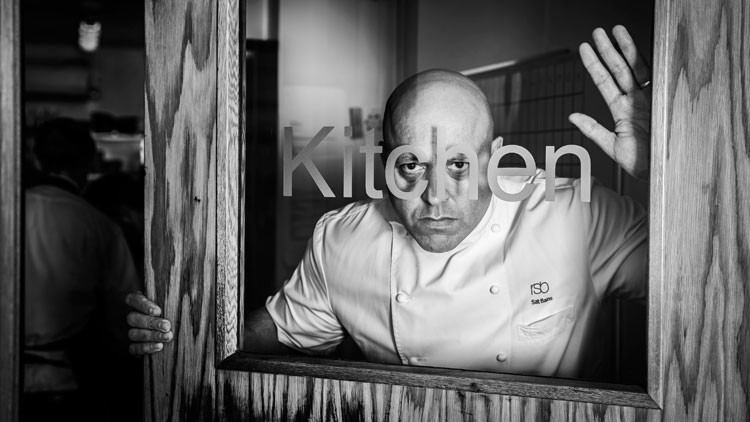
DO
LET US KNOW WHEN
“Ultimately, I’d open a shed in a shit hole if I
could.”—Sat Bains, chef-owner of Sat Bains
restaurant in “Devil in the Kitchen” by Stefan
Chomka, Restaurant
Magazine (2/19).
❖❖❖
Wine
Column Sponsored by Banfi Vintners
SANGIOVESE
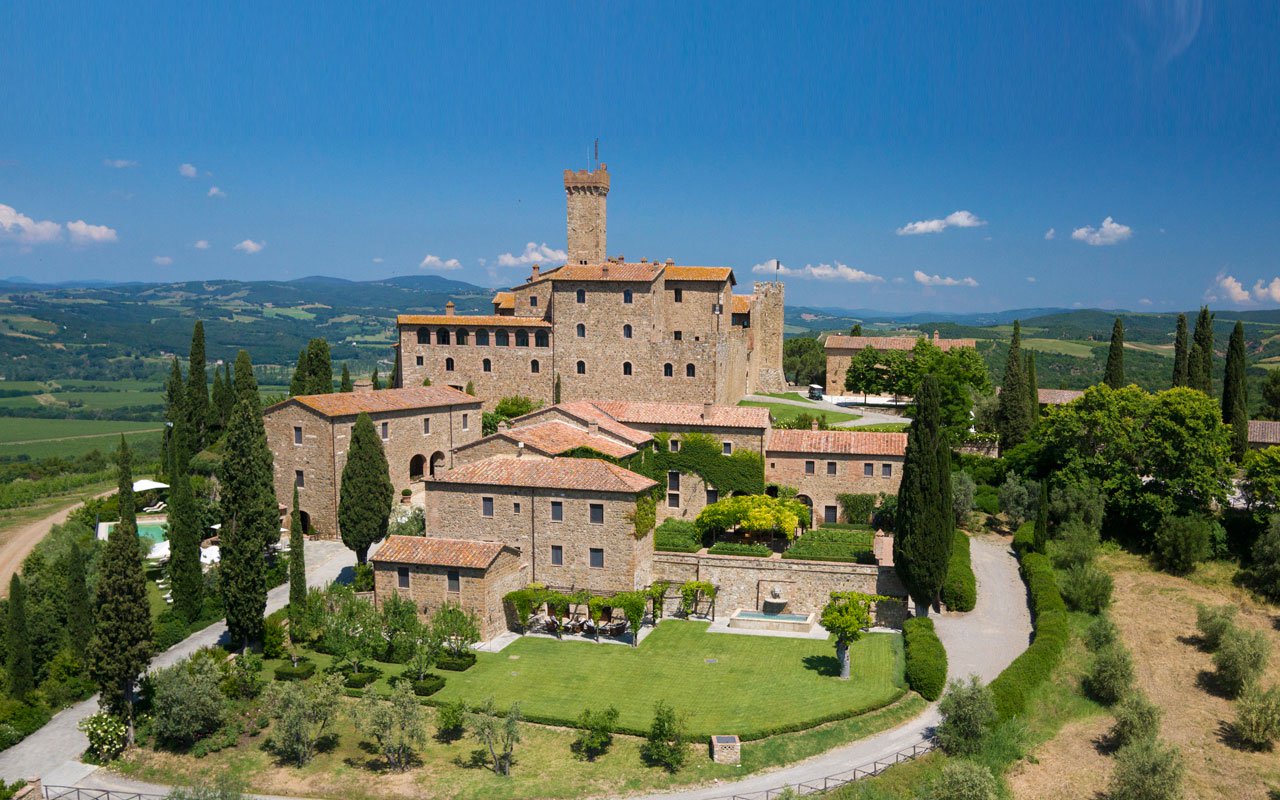 Wine is a joy year-round but
in cooler weather one
grape varietal has really taken center stage in
my daily activities – that most Italian of
grapes, Sangiovese, and its ultimate expression
– Brunello di Montalcino.
Wine is a joy year-round but
in cooler weather one
grape varietal has really taken center stage in
my daily activities – that most Italian of
grapes, Sangiovese, and its ultimate expression
– Brunello di Montalcino.
From mid-September through mid-October,
the Sangiovese grown for our various styles of red
wines are be harvested, culminating with the top
selection for Brunello di Montalcino.
Second, cooler weather here means
it is time to start enjoying more red wines and
especially Sangiovese based wines. That
includes Banfi’s cru of Brunello, Poggio alle Mura,
literally the cream of the crop of our Sangiovese
vineyards. Alongside our Poggio alle Mura Brunello di
Montalcino, this year we introduced two more wines
from the cru Poggio alle Mura – a Rosso di Montalcino
and a Riserva of Brunello. Rosso is sort of like the
younger brother of Brunello, also made from 100%
Sangiovese grapes but usually a selection from younger
vines and the wine is aged only two years compared to
the four required for Brunello. The
Riserva, on the other hand, is an even more selective
harvest of Sangiovese, and ages for an additional year
before release.
What is so special about this cru
Poggio alle Mura?
Well, it is the result our over 30 years of
ongoing research at my family’s vineyard estate,
Castello Banfi.
When we first began planting our vines there in
the late 1970s studies from the University of Bordeaux
indicated which strains of many varietals we should
plant, based on the soil type and microclimate of each
vineyard. But
when it came to the region’s native Sangiovese, there
was only local lore, no scientific research. So we took
it upon ourselves to figure out this vine, and set off
on three decades of incredibly detailed research.
We started
with 600 apparent variations on Sangiovese, because it
is so susceptible to variations in weather and soil,
and narrowed that down to 160 truly genetically
different clones.
We planted a vineyard with two rows of each
type, made wine from each of them, and charted the
differences – remember, you only get one chance a year
to make wine, so this took time.
It took about ten years to get some
concrete results, though we continue to experiment
today and always will – you never stop learning in
science and nature!
Once we determined which were the best,
complementary clones that could be planted together to
make the best Brunello, we chose to plant them in what
we determined to be the optimal vineyard sites. Coincidentally,
the best soils and climate conditions are in the
slopes surrounding the medieval fortress today known
as Castello Banfi, known since Etruscan times as
Poggio alle Mura – the walled hilltop. Hence the
name of our most special “cru” of Brunello,
representing a synthesis between tradition and
innovation.
Though the focus of this study was
our Brunello, all of our Sangiovese-based wines,
including the super Tuscans SummuS, Cum Laude, and
Centine, benefitted from this work. And that’s
the third reason for celebrating Sangiovese this
month, for the range of wonderful reds that usher us
into autumn! One
wine in particular was inspired by our research – the
BelnerO, a Sangiovese dominant blend with what I like
to call a kiss of Cabernet and a whisper of Merlot. We grow the
grapes a little differently for BelnerO than for
Brunello, make the wine with less oak aging and
released it earlier from the winery, providing a
counterpoint to Brunello and a lovely terroir-driven
wine in its own right.
If you
know Italians, you know that by nature we are
multi-faceted, varying in mood, and always passionate. As a
nation, we span from the hot sunny beaches of Sicily
near the African coast to the rugged mountains and
Alpine ski slopes of Trentino-Alto Adige in the north. Sangiovese
is grown in almost all of Italy’s regions and reflects
the unique nature of each; it is most famous
(rightfully so) in Tuscany, yet even there it reflects
the nuances of each hilltop, valley and subzone. It has
something a little different to say in Brunello than
Chianti, Morellino than Vino Nobile di Montepulciano,
Rosso di Montalcino than Super Tuscan blends.
Here is a smattering of
Sangiovese-based wines that you may wish to get to
know better, reflecting a spectrum that appeals to
every occasion, every taste, and every budget. We can
assure you that the conversation will never become
boring. 
Recommendations for Celebrating
Sangiovese
BelnerO Proprietor’s Reserve Sangiovese
– A refined
cuvée of noble red grapes perfected by our pioneering
clonal research. This dark beauty, BelnerO, is
produced at our innovative winery, chosen 11
consecutive years as Italy’s Premier Vineyard Estate.
Fermented in our patented temperature controlled
French oak and aged approximately 2 additional years.
Unfiltered, and Nitrogen bottled to minimize sulfites.
Castello Banfi Brunello di Montalcino –
Rich, round, velvety and intensely
aromatic, with flavor hints of licorice, cherry, and
spices. Brunello di Montalcino possesses an intense
ruby-red color, and a depth, complexity and opulence
that is softened by an elegant, lingering aftertaste.
Unfiltered after 1998 vintage.
Castello Banfi Rosso di Montalcino – Brunello's "younger brother," produced
from select Sangiovese grapes and aged in barrique for
10 to 12 months. Deep ruby-red, elegant, vibrant,
well-balanced and stylish with a dry velvety
finish.
Poggio all’Oro Brunello di Montalcino
Riserva – A single vineyard selection of our most
historically outstanding Sangiovese, aged five years
before release, the additional year more than that
required of Brunello including 6 months in barrel and
6 months more in bottle to grant its “Riserva”
designation. Incredible
elegance and harmony. Intense with lots of fruit and
subtle wood influence. Round, complete, well balanced
with hints of chocolate and berries. Unfiltered after
1998.
Poggio alle Mura – The first tangible result of years of
intensive clonal research on Montalcino’s native
Sangiovese grape.
Estate bottled from the splendidly sun drenched
vineyards surrounding the medieval Castello from which
it takes its name.
The Brunello
di Montalcino is seductive, silky and smoky. Deep ruby
in color with an expressive bouquet of violets, fruits
and berries as well as cigar box, cedar and exotic
spices. The Rosso
di Montalcino is also intense ruby red. The bouquet
is fresh and fruity with typical varietal notes of
cherry and blackberry, enriched by more complex hints
of licorice, tobacco and hazelnut. It is full
bodied, yet with a soft structure, and a surprisingly
long finish. The Poggio alle Mura Brunello di Montalcino
Riserva is deep ruby red with garnet
reflections and a rich, ample bouquet that hints of
prune jam, coffee, cacao and a light balsamic note. It is full
and powerful, with ripe and gentle tannins that make
it velvety and harmonious; this wine is supported by a
pleasing minerality that to me speaks soundly of that
special hillside in southern Montalcino.
SummuS – A wine of towering elegance, SummuS is an
extraordinary blend of Sangiovese which contributes
body; Cabernet Sauvignon for fruit and structure; and
Syrah for elegance, character and a fruity bouquet. An elegant,
complex and harmonious red wine.
Cum Laude – A complex and elegant red which graduated
“With Honors,” characterized by aromas of juicy
berries and fresh spices.
Centine – A Cuvee that is more than half
Sangiovese, the balanced consisting of equal parts of
Cabernet Sauvignon and Merlot. Vinified in
a firm, round style that easily accompanies a wide
range of dishes, this is a smooth and fragrantly
satisfying wine with international character, and a
perennial favorite at my own dinner table.
Banfi Chianti Superiore – The “Superiore” designation signifies
stricter government regulations regarding production
and aging requirements, as compared to regular
Chianti. An
intense ruby red wine with fruit forward aromas and
floral notes. This
is a round wine with well-balanced acidity and fruit.
Banfi Chianti Classico – An enduring classic: alluring
bouquet of black fruit and violets; rich flavors of
cherry and leather; supple tannins and good acidity
for dining.
Banfi Chianti Classico Riserva – Produced from select grapes grown in the
"Classico" region of Chianti, this dry, fruity and
well-balanced red has a full bouquet reminiscent of
violets.
Fonte alla Selva Chianti Classico – This is our newest entry into the Chianti
arena, coming from a 99 acre estate in Castellina, the
heart of the Chianti Classico region. The wine is
a captivating mauve red that smells of cherry, plum
and blackberry with hints of spice. It is
round, full and balanced with very good
acidity.
Col di Sasso – Sangiovese and Cabernet Sauvignon. Luscious,
complex and soft with persistent notes of fruit and
great Italian style structure.
Any of John Mariani's books below may be ordered from amazon.com.
 The Hound in Heaven
(21st Century Lion Books) is a novella, and
for anyone who loves dogs, Christmas, romance,
inspiration, even the supernatural, I hope you'll find
this to be a treasured favorite. The story
concerns how, after a New England teacher, his wife and
their two daughters adopt a stray puppy found in their
barn in northern Maine, their lives seem full of promise.
But when tragedy strikes, their wonderful dog Lazarus and
the spirit of Christmas are the only things that may bring
his master back from the edge of despair.
The Hound in Heaven
(21st Century Lion Books) is a novella, and
for anyone who loves dogs, Christmas, romance,
inspiration, even the supernatural, I hope you'll find
this to be a treasured favorite. The story
concerns how, after a New England teacher, his wife and
their two daughters adopt a stray puppy found in their
barn in northern Maine, their lives seem full of promise.
But when tragedy strikes, their wonderful dog Lazarus and
the spirit of Christmas are the only things that may bring
his master back from the edge of despair. WATCH THE VIDEO!
“What a huge surprise turn this story took! I was completely stunned! I truly enjoyed this book and its message.” – Actress Ali MacGraw
“He had me at Page One. The amount of heart, human insight, soul searching, and deft literary strength that John Mariani pours into this airtight novella is vertigo-inducing. Perhaps ‘wow’ would be the best comment.” – James Dalessandro, author of Bohemian Heart and 1906.
“John Mariani’s Hound in Heaven starts with a well-painted portrayal of an American family, along with the requisite dog. A surprise event flips the action of the novel and captures us for a voyage leading to a hopeful and heart-warming message. A page turning, one sitting read, it’s the perfect antidote for the winter and promotion of holiday celebration.” – Ann Pearlman, author of The Christmas Cookie Club and A Gift for my Sister.
“John Mariani’s concise, achingly beautiful novella pulls a literary rabbit out of a hat – a mash-up of the cosmic and the intimate, the tragic and the heart-warming – a Christmas tale for all ages, and all faiths. Read it to your children, read it to yourself… but read it. Early and often. Highly recommended.” – Jay Bonansinga, New York Times bestselling author of Pinkerton’s War, The Sinking of The Eastland, and The Walking Dead: The Road To Woodbury.
“Amazing things happen when you open your heart to an animal. The Hound in Heaven delivers a powerful story of healing that is forged in the spiritual relationship between a man and his best friend. The book brings a message of hope that can enrich our images of family, love, and loss.” – Dr. Barbara Royal, author of The Royal Treatment.
 |
The Encyclopedia of American Food and Drink by John F. Mariani (Bloomsbury USA, $35) Modesty forbids me to praise my own new book, but let me proudly say that it is an extensive revision of the 4th edition that appeared more than a decade ago, before locavores, molecular cuisine, modernist cuisine, the Food Network and so much more, now included. Word origins have been completely updated, as have per capita consumption and production stats. Most important, for the first time since publication in the 1980s, the book includes more than 100 biographies of Americans who have changed the way we cook, eat and drink -- from Fannie Farmer and Julia Child to Robert Mondavi and Thomas Keller. "This book is amazing! It has entries for everything from `abalone' to `zwieback,' plus more than 500 recipes for classic American dishes and drinks."--Devra First, The Boston Globe. "Much needed in any kitchen library."--Bon Appetit. |
"Eating Italian will never be the same after reading John Mariani's entertaining and savory gastronomical history of the cuisine of Italy and how it won over appetites worldwide. . . . This book is such a tasteful narrative that it will literally make you hungry for Italian food and arouse your appetite for gastronomical history."--Don Oldenburg, USA Today. "Italian
restaurants--some good, some glitzy--far
outnumber their French rivals. Many of
these establishments are zestfully described
in How Italian Food Conquered the World, an
entertaining and fact-filled chronicle by
food-and-wine correspondent John F.
Mariani."--Aram Bakshian Jr., Wall Street
Journal.
"Equal parts
history, sociology, gastronomy, and just
plain fun, How Italian Food Conquered the
World tells the captivating and delicious
story of the (let's face it) everybody's
favorite cuisine with clarity, verve and
more than one surprise."--Colman Andrews,
editorial director of The Daily
Meal.com. "A fantastic and fascinating
read, covering everything from the influence
of Venice's spice trade to the impact of
Italian immigrants in America and the
evolution of alta cucina. This book will
serve as a terrific resource to anyone
interested in the real story of Italian
food."--Mary Ann Esposito, host of PBS-TV's
Ciao
Italia. "John Mariani has written the
definitive history of how Italians won their
way into our hearts, minds, and
stomachs. It's a story of pleasure over
pomp and taste over technique."--Danny Meyer,
owner of NYC restaurants Union Square
Cafe, The Modern, and Maialino.
|
 |
 |
 |
 |
 |
 |
 |
 |
 Everett Potter's Travel Report:
Everett Potter's Travel Report: 
 Eating Las Vegas
JOHN CURTAS has been covering the Las Vegas
food and restaurant scene since 1995. He is
the co-author of EATING LAS VEGAS – The 50
Essential Restaurants (as well as
the author of the Eating Las Vegas web site: www.eatinglasvegas.
He can also be seen every Friday morning as
the “resident foodie” for Wake Up With the
Wagners on KSNV TV (NBC) Channel 3 in
Las Vegas.
Eating Las Vegas
JOHN CURTAS has been covering the Las Vegas
food and restaurant scene since 1995. He is
the co-author of EATING LAS VEGAS – The 50
Essential Restaurants (as well as
the author of the Eating Las Vegas web site: www.eatinglasvegas.
He can also be seen every Friday morning as
the “resident foodie” for Wake Up With the
Wagners on KSNV TV (NBC) Channel 3 in
Las Vegas.
MARIANI'S VIRTUAL GOURMET
NEWSLETTER is published weekly. Publisher: John Mariani. Editor: Walter Bagley. Contributing Writers: Christopher Mariani,
Robert Mariani, Misha Mariani, John A. Curtas, Gerry Dawes, Geoff Kalish,
and Brian Freedman. Contributing
Photographer: Galina Dargery. Technical
Advisor: Gerry
McLoughlin.
If you wish to subscribe to this
newsletter, please click here: http://www.johnmariani.com/subscribe/index.html
© copyright John Mariani 2019

